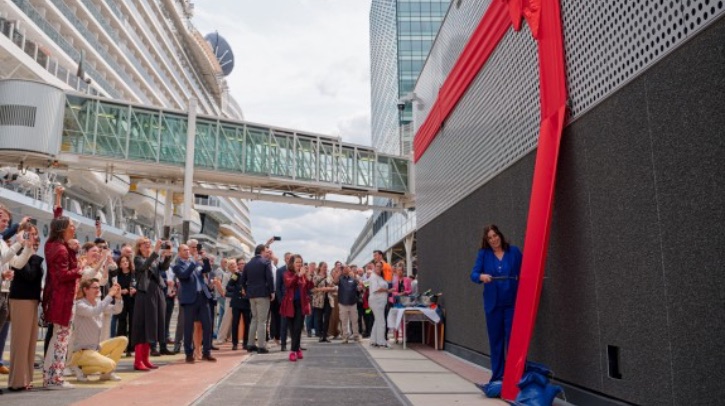The Passenger Terminal Amsterdam (PTA) has officially opened its shore power facility. With an expected 100 calls per year, this initiative is projected to reduce approximately three metric tons of particulate matter, 100 metric tons of nitrogen and 4.8 metric kilotons of CO2.
The green electricity comes in part from the Ruigoord wind farm in the port of Amsterdam. The new installation means ships can turn off their generators as soon as they dock, which reduces emissions and noise. From 2027, the use of shore power will be mandatory at this location, so this shore power installation is three years ahead of the European regulations’ requirement.
4.4km of cable under the Ij
The installation began in May 2023 and was completed in early 2025. The Danish company Powercon supplied the system, with BAM Infra Nederland as a subcontractor. Grid operator Liander passed a total of 4.4km of cable under the IJ river, between a substation in Amsterdam-Noord and the Passenger Terminal Amsterdam (PTA) on the Veemkade. There is also 8km of cable under the quay and the scaffolding decks. The installation was made possible by subsidies from the Ministry of Infrastructure and Water Management and the European Commission.
Smart energy hub
Alongside this shore power facility, a smart energy hub has been built on the quay of the Passenger Terminal Amsterdam. The grid operator’s installations, the transformers and the shore power installations are set up in this building. From here, the shore power cabinets on the quay are supplied with power. With the cable management system, 50m of cable can be rolled out of the shore power box and connected to the ship.
Contribution to climate goals
With the commissioning of this shore power installation, the Port of Amsterdam contributes to the city’s goal of being climate neutral by 2050. According to the port, sea cruise ships already equipped for shore power will have priority in Amsterdam.
In addition to the commitment to sea cruises, the port is also investigating how the shore power facility can be used in other ways as a power point for the city. In particular, the team is targeting the electrification of the cruise tourism sector (such as coaches).
Dick de Graaff, director of Cruise Port Amsterdam, stated, “With the commissioning of shore power, we are taking a big step toward a quieter, cleaner and more sustainable port. This is good for residents, visitors and the climate and proves that our cruise terminal has the innovative power to shape the future of responsible tourism.”
Hester van Buren, alderman for the port, who officially opened the installation, said, “I am very pleased that the PTA and the port company have taken this step so vigorously to install shore power here. It shows what is possible if you share ambitions and join forces. This installation is tangible proof that sustainability is not something of tomorrow – but of today.”
Dorine Bosman, chief investment officer at Port of Amsterdam, stated, “With this shore power supply, we are taking an important step toward a livable city, a sustainable port and making the cruise more sustainable. The central location of the terminal calls for quiet and clean solutions – and we now offer them.”
In related news, LS Eco Advanced Cables (LSEAC) recently launched a five-week public consultation on its proposals to develop a high-voltage cable production facility at the Port of Tyne, for undersea electricity transmission. This is intended to transport clean energy generated by offshore wind onto UK shores. While plans are at an early stage and still being finalized, total investment is expected to be approximately £923m (US$1.2m). Read the full story here



